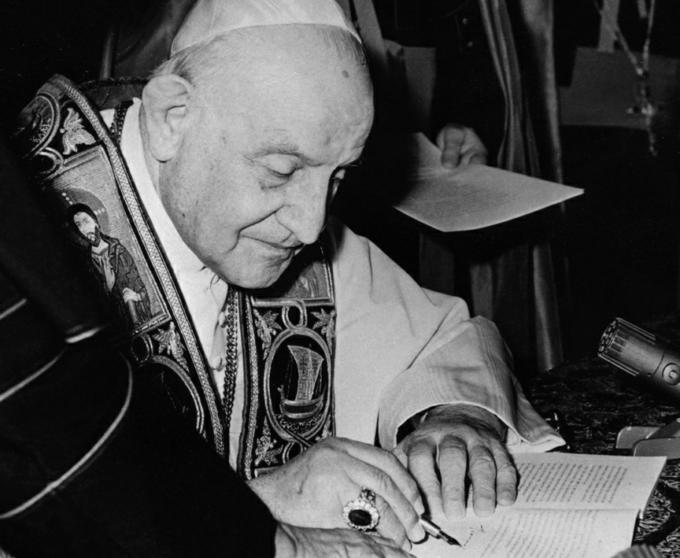
Culture
Finally, "Pacem in Terris" taught that the arms race was a snare and a delusion; universal disarmament was a moral imperative demanded by right reason, for, "in an age such as ours, which prides itself on its atomic energy, it is contrary to reason to hold that war is now a suitable way to restore rights which have been violated."

Weigel
On April 11, 1963, John XXIII issued the encyclical "Pacem in Terris," a powerful call for a world in which there were neither victims nor executioners that cemented the pontiff's reputation as "Good Pope John." With the world having teetered on the brink of nuclear war during the October 1962 Cuban missile crisis, a papal appeal for "peace on earth" was well received everywhere, including the Soviet Union -- although the view in some Vatican quarters that the masters of the Kremlin took the encyclical's message to heart was rather naÏve.
What, then, did "Pacem in Terris" teach? And how does its analysis of world affairs look, six decades later?
John XXIII taught that the world had entered a new historical moment, characterized by the widespread conviction that "all men are equal by reason of their natural dignity." That conviction implied that the classic Catholic social doctrine principle of the common good had a global, not only national, dimension -- which in turn meant that "peace on earth" had to be pursued through the establishment of a "worldwide public authority." That global authority ought to make the protection and promotion of human rights -- which Pope John defined expansively -- its fundamental objective.
As for communist states, they, too, ought to be enfolded within the global political community, for communist movements, whatever their "false philosophical teachings," might nonetheless "contain elements that are positive and deserving of approval." Finally, "Pacem in Terris" taught that the arms race was a snare and a delusion; universal disarmament was a moral imperative demanded by right reason, for, "in an age such as ours, which prides itself on its atomic energy, it is contrary to reason to hold that war is now a suitable way to restore rights which have been violated."
For all that John XXIII's grand vision inspired hope that the world could find its way beyond the knife's-edge stalemate of the Cold War, the lacunae in the encyclical that friendly critics pointed out after it was issued ---- its lack of attention to the realities of power in world politics, its misreading of the intrinsic linkage between Marxist ideas and totalitarian politics, its seeming indifference to the enduring effects of original sin in the political sphere -- were, in the retrospect of 60 years, deficiencies indeed.
The Cold War ended, not because "trust" (another key theme in the encyclical) had been established between imperfect democracies and pluperfect tyrannies; it ended thanks to what William Imboden (in "The Peacemaker: Ronald Reagan, The Cold War, and the World on the Brink") describes as the strategy of "negotiated surrender" devised by the United States and supported by its western allies. And while an arms race did, in the 1980s, intensify the dangers of nuclear war at several moments, it also broke the capacity (and will) of the Soviet Union to continue the competition.
As for the encyclical's proposal for the development of a "universal public authority" capable of addressing issues of global import, the incapacities and corruptions displayed by the United Nations since "Pacem in Terris" was issued, not least in the defense of basic human rights, have raised serious questions about both the feasibility (even desirability) of any such enterprise.
John XXIII's welcome stress on human rights as an important issue in international public life was validated by the revolution of conscience -- the human rights revolution -- that his third successor, John Paul II, ignited in east central Europe in 1979: a revolution that was another key factor in the nonviolent collapse of European communism. But neither the Church nor world politics has been well-served by the tendency in "Pacem in Terris" to label as a "human right" virtually every political, social and economic desirable; a tendency that has subsequently become an irresistible temptation for the Holy See in its address to world politics.
In his commentary on the encyclical, the great Jesuit theologian John Courtney Murray argued that John XXIII's notion of the ideal political community -- what Murray described as "the free man under a limited government" -- was drawn from Thomas Aquinas. Yet if "Pacem in Terris" drew part of its inspiration from the Angelic Doctor, where in the encyclical did one find echoes of Augustine, that other great master of classic Catholic political theory? Was the pope, some asked, sufficiently aware of the expansiveness of human political folly, and the dangers of tyranny embedded in utopian visions of human perfectibility, as Augustine surely was?
An inspiring and noble vision, an inadequate analysis of the obstacles to that vision's realization: that seems a reasonable judgment on "Pacem in Terris" at its 60th anniversary.
- George Weigel is Distinguished Senior Fellow of the Ethics and Public Policy Center in Washington, D.C.
Recent articles in the Culture & Events section
-
'Dignitas' and the mediaRussell Shaw
-
Scripture Reflection for April 14, 2024, Third Sunday of EasterDeacon Greg Kandra
-
St. Helena's House is established in the South EndThomas Lester
-
Is this synodality?Russell Shaw
-
Poking the hornet's nest of IVFFather Tadeusz Pacholczyk


















